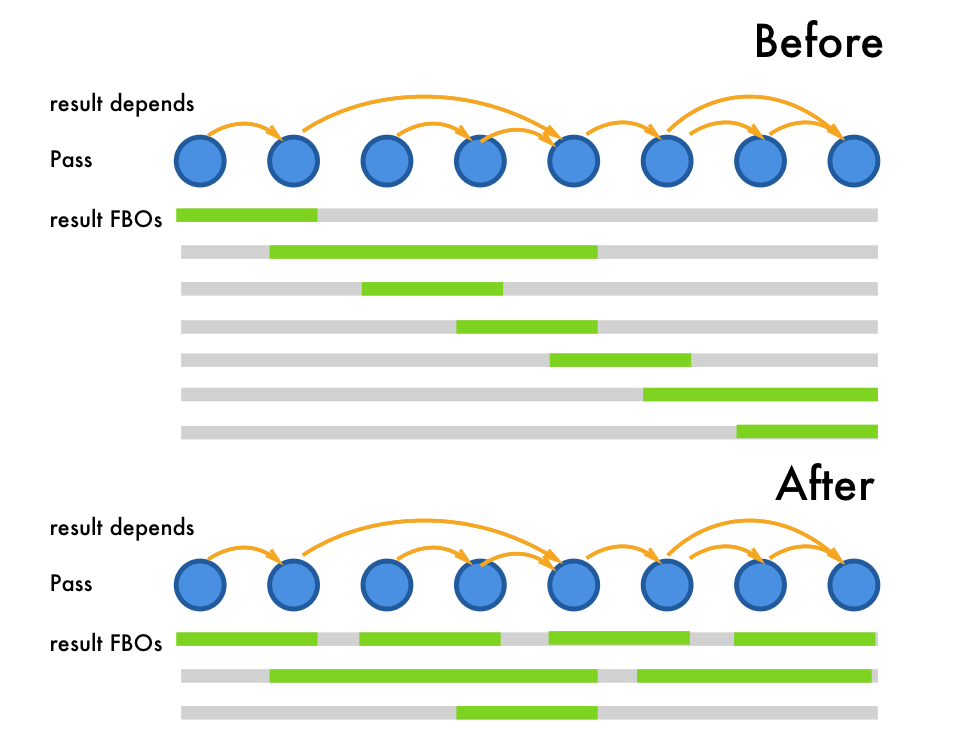这周末做了基于RenderGraph的Framebuffer重用。借此机会撰写一些关于reuse fbo的设计。
当我们在写后处理的时候,我们会写很多pass, 有的pass单纯的使用场景的shader画场景,更多的使用特殊的shader覆盖场景的shader进行绘制,有的pass处理之前pass绘制的结果,还有的pass处理多个之前pass的结果。你构建整个后处理的工作,事实上就是给这些pass分配绘制的target,并把这些target再提供给后续依赖的pass,来组合这些pass得到最终的屏幕效果。
很显然,整个后处理流程可以使用有向无环图进行抽象, RenderGraph就是我在artgl里完成的实现。
记得当时在我从前端转职到图形的时候,我最大的感慨是,没有一个顺手的webgl框架可用,对于之前vue什么写惯了的前端来说,组件化的模块化的抽象是深入人心的。市面上很难找到一个webgl框架,提供合理的针对渲染这个行为的模块化抽象。这大概是最早的一些想法。
后来,公司的项目里开始有一些后处理要做,这些后处理流程越来越多,充斥着大量非常丑陋的实现。于是我看不下去了,设计了一个graph的系统,通过声明式的api模块化后处理管线,希望能重构公司项目里整个后处理流程,我保证说整个后处理管线代码量下降一半,开发效率翻倍,但是我并没有得到机会做这个事情。于是乎我只能在artgl里做了。
为什么这周末突然做了fbo重用的实现呢?因为上周同事反馈移动端因为fbo大量申请导致崩溃的问题,这显然原因就是fbo没有复用的后果。我不敢想象在公司的项目里,没有graph的抽象,去人肉分辨出用到的十个fbo,谁在什么时候可以释放,谁可以给谁用,和动态配置如何配合,这种代码实在是不敢写,也没法写。
而这时我想到正因为artgl做了graph的后处理,整个graph,这个pass依赖哪个pass的结果,那个pass的结果在哪一步再也不需要保留内容了,这些优化信息全部可以自动收集,所以基于graph做fbo的自动reuse是很简单的事情。
如果所有fbo都是一个格式和大小,那么大概是这个效果:

具体的做法是三部分:
1 每个 renderTargetNode 不再有一一对应的fbo,这些fbo也不在图构建的时候直接申请,取而代之,向一个fbo pool请求,fbo pool会根据 renderTargetNode 上的格式信息,比如长宽等,生成formatKey字符串,pool持有一个formatKey -> fbo[] 的map,取一个就pop一个,如果没有符合格式的直接向gl申请,这是取的过程。还有一个还回来的接口表示这个fbo我用完了,上面的内容后续没有依赖了,可以继续重用, push到对应的map里的array里。
2 每个renderPass不再向对应的output target和dependency的nodes索取fbo,而是 rendergraph的执行器,effectComposer, 在执行pass前完成相应的工作。 composer自己会持有一份targetName到fbo的map, 表示当前哪些fbo的内容需要keep。composer会在renderPass执行前,获取所需的fbo,如果这个是之前keep住的,那么就取keep的fbo,如果没有就问pool申请,并在pass结束后,按需归还不再使用的fbo。
3 composer需要知道这个pass结束后,哪些kept的fbo可以return给pool,那么在构建图的时候,拓扑排序完,得到的renderPass array,需要计算一个droplist array, 就是走到哪一个pass,哪些之前用的fbo再也不需要保留内容了。根据这个list,composer便可以实现按需归还fbo。
在某些情况下,某个pass的结果即便后续没有任何引用,依然需要一直keep住。比如temporal的ping pong buffer, 需要让这个target隔帧的进行reuse。 又比如 如果你需要某个target在render之外能支持readPixel, 那么你也需要一直keep。为了支持这种情况, renderGraph api在声明target节点时,提供了 keepContent的 getter, 默认永远返回false
1 | export interface RenderTargetDefine { |
这是目前的带两个temporal的demo,你可以看到跨帧交替释放是如何支持的,我现在已经可以放心的继续往后叠ao的blur和glow的效果,不用担心要多出四个屏幕大小的fbo了。
1 | graph.defineGraph({ |